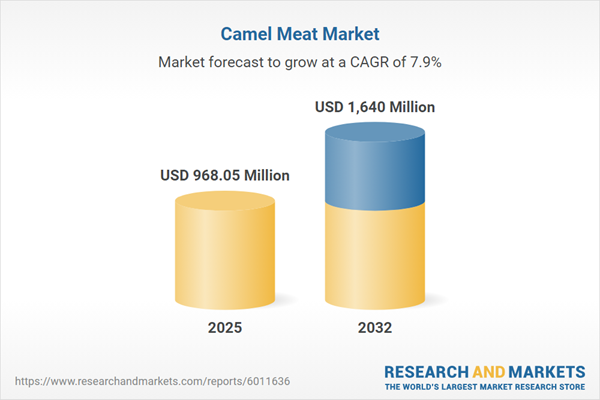Speak directly to the analyst to clarify any post sales queries you may have.
The camel meat market is evolving from a regional specialty to a recognized global alternative protein, driven by shifting consumer preferences and increasing interest in sustainable, nutrient-rich meats. Senior decision-makers in the protein sector require a clear understanding of market shifts, regulatory environments, and new opportunities presented by this dynamic landscape.
Market Snapshot: Camel Meat Market Size, Growth & Outlook
The camel meat market grew from USD 896.64 million in 2024 to USD 968.05 million in 2025 and is projected to reach USD 1.64 billion by 2032, reflecting a CAGR of 7.86%. A combination of consumer curiosity, advances in sustainable livestock practices, and broader adoption of alternative proteins continues to support robust growth. Expanded distribution channels, evolving foodservice applications, and innovation in processing technologies further enhance the market’s trajectory.
Scope & Segmentation
This report delivers a comprehensive analysis of the global camel meat industry by segment, region, and technology. Strategic segmentation enables targeted investment and operational decisions.
- Product Types: Fresh, Frozen
- Distribution Channels: Butchers, Convenience Stores, E-Commerce (Proprietary and Third-Party Platforms), Hypermarkets & Supermarkets
- End Users: Food Service (Full-Service Restaurants: Casual and Fine Dining, Quick Service Restaurants), Institutional, Retail (Households, Specialty Butchers, Supermarkets)
- Form Factors: Cuts, Minced, Whole Carcass
- Regions: Americas (North America, Latin America), Europe, Middle East & Africa (Europe, Middle East, Africa), Asia-Pacific (China, India, Japan, Australia, South Korea, Indonesia, Thailand, Malaysia, Singapore, Taiwan)
- Leading Companies: Al Dahra Agriculture Joint Stock Company, Almarai Company, National Agricultural Development Company, Emirates Industry for Camel Milk & Products LLC, Halal International Co. for Foodstuff Trading, Outback Camel Meat Pty Ltd, Vogel Meat Pty Ltd, Midamar Corporation, Eastern Food Industries Company, Fettayleh Foods Pty Ltd
- Technologies & Initiatives: Cold-chain logistics, vacuum packaging, genetic improvement in herds, advanced animal welfare and traceability systems, digital B2B procurement platforms
Camel Meat Market: Key Takeaways
- Consumer demand is moving beyond traditional markets, with increased visibility in gourmet and premium foodservice channels.
- Technological advances in storage and distribution are improving meat quality and extending shelf life, facilitating market expansion.
- Sustainability considerations are positioning camel meat as an environmentally resilient protein, with lower water and feed requirements than conventional livestock in arid zones.
- The rise of branded product lines, digital sales platforms, and institutional procurement is boosting channel diversity and brand recognition.
- Collaboration among producers, researchers, and logistics experts accelerates product innovation and quality assurance.
- Tailored regional and segment-specific approaches remain essential for regulatory compliance and market acceptance.
Tariff Impact: 2025 U.S. Policy Changes
Recent U.S. tariff adjustments have introduced new complexity to sourcing and pricing strategies. Importers are seeking diversified supply origins and long-term agreements to protect margins, while domestic producers look to lower import dependency by expanding breeding programs. Retailers and restaurants are revising pricing and menu strategies to maintain consumer accessibility and business profitability in the changing trade landscape. Stakeholder vigilance on policy updates will be critical for capturing new market opportunities.
Methodology & Data Sources
This research synthesizes insights from primary interviews with stakeholders across the camel meat supply chain, combined with secondary data from trade publications, regulatory sources, and industry surveys. Triangulation ensures robustness, while scenario analysis captures the impact of regulatory, technological, and economic shifts on market outlook.
Why This Report Matters
- Enables informed, data-driven decisions for investment and expansion within the global camel meat sector.
- Offers actionable analysis of consumer trends, supply chain advancements, and evolving policy structures impacting key segments.
- Supports future-facing strategy development through robust coverage of market forces, innovation, and competitive benchmarks.
Conclusion
The camel meat market presents distinct opportunities for those prepared to address evolving consumer needs, regulatory changes, and innovation in proteins. Strategic engagement and investment informed by this report will strengthen competitive positioning and support sustainable market growth.
Additional Product Information:
- Purchase of this report includes 1 year online access with quarterly updates.
- This report can be updated on request. Please contact our Customer Experience team using the Ask a Question widget on our website.
Table of Contents
3. Executive Summary
4. Market Overview
7. Cumulative Impact of Artificial Intelligence 2025
Companies Mentioned
The companies profiled in this Camel Meat market report include:- Al Dahra Agriculture Joint Stock Company
- Almarai Company
- National Agricultural Development Company
- Emirates Industry for Camel Milk & Products LLC
- Halal International Co. for Foodstuff Trading (EIFFCO Group)
- Outback Camel Meat Pty Ltd
- Vogel Meat Pty Ltd
- Midamar Corporation
- Eastern Food Industries Company
- Fettayleh Foods Pty Ltd
Table Information
| Report Attribute | Details |
|---|---|
| No. of Pages | 195 |
| Published | November 2025 |
| Forecast Period | 2025 - 2032 |
| Estimated Market Value ( USD | $ 968.05 Million |
| Forecasted Market Value ( USD | $ 1640 Million |
| Compound Annual Growth Rate | 7.8% |
| Regions Covered | Global |
| No. of Companies Mentioned | 11 |









